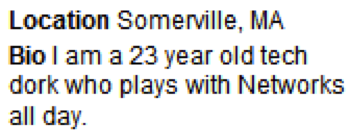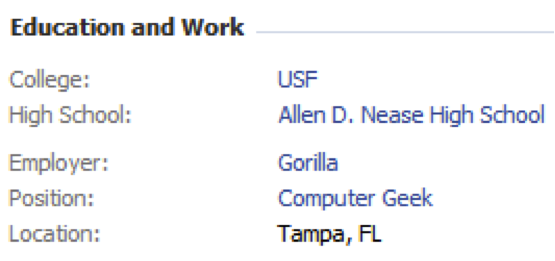Non-Standard Descriptors and the Role They Play in Social Media
Sourcing has always been a significant component in the recruiting lifecycle. However, in recent years, sourcing has taken a giant step into the forefront and has become recognized as the solid foundation upon which successful recruiting rests in order to identify and secure top-level talent, no matter what industry you may be supporting.
These days, it seems as if nearly everyone from CEOs of Fortune 500 companies, to inventors in various fields, to the grandmother of your best friend has a Facebook page, a LinkedIn profile, or a Twitter account.
Although some people are still discovering and testing the waters of the Twitterverse, a diverse and large population spanning nearly all industry segments has already fully jumped on to the real-time messaging bandwagon in order to share information or blurt out a piece of nonsense rolling around in their head.
Understand Social Media Users
With the significant levels of attention and traffic being driven by Social Media, it’s critical for sourcers and recruiters to understand how to best use Social Media for talent identification. Technology is ever evolving and those of us in sourcing/recruiting/talent acquisition roles (even we have many titles!) constantly have to play catch-up with those that create each new Social Media application.
After attending a webinar put on by Glen Cathey a couple years ago, I had an epiphany. It’s true – we need to build the right search strings in order to filter through and find the right people we are targeting. In order to do that effectively, I realized that we as sourcers need to understand the psychology of the people we’re searching for and be aware of how they think of and refer to themselves in order to return highly relevant results when searching Social Media.
Social Media Offers a Creative Outlet
Social Media is a relatively new outlet where professionals of any industry can be creative and a little looser with how they refer to themselves. There’s definitely a drive for people to look for cool and hip new ways to describe who they are and what they do. Social Media, which is informal, dynamic, and somewhat voyeuristic, enables people to create alter-ego profiles for friends and peers to view and delight in.
On a standard resume or on a professional social networking site such as LinkedIn, most people will refer to themselves by their industry-standard titles such as Programmer, Developer, Engineer, Marketer, etc. However, when it comes to Social Media, many people purposely avoid “corporate” and resume-level descriptors and ”tag” themselves using more informal language that results in a more personalized identity, rather than conforming to industry-standard job titles. For example, the computer programmer at work becomes “geek” or “tech nerd” in his/her Twitter bio. While these may not be considered “professional” descriptors, they are important to note in order to be able to effectively target and search for talent on Facebook and Twitter. This requires us to shift our way of thinking in the way we search for people.
Twitter and many other Social Media interfaces have advanced search options or third party applications that enable you to search the “bio” areas of a person’s profile. When searching these Social Media applications, you must be careful not to limit yourself to the “standard” search terms. You must be open to non-standard descriptors such as “geek,” “nerd,” “techie,” “evangelist,” “droid,” “drone,” “junkie,” and “enthusiast” to name a few. In my sourcing efforts I’ve come across all of these non-title descriptors multiple times in people’s bios.
Examples of Non-Standard Descriptors – Twitter


![]()


Examples of Non-Standard Descriptors – Facebook




Non-Standard Location Descriptors
Sourcers and recruiters also need to think outside of the box when it comes to searching Social Media applications for candidates in specific locations and challenge their traditional thinking towards standard naming conventions as it relates to locations. Many people with Social Media profiles are being quite creative when describing where they are from.
Searching profiles on Twitter and Facebook will yield you non-standard, yet recognizable results such as Silicon Valley, Central New York, North NJ, Suburbs of Boston, NoCal, and Southern CA. However, some people take it a step further and utilize popular slang terms – for example: City of Angels, Big Apple, Bay area, and Chi Town. There are the even more creative “tweeps” that want to remain mysterious, their location may be “Universe,” “Everywhere,” or “Narnia.” Perhaps even more intriguing is that some people simply list their latitude and longitude via their iPhones.
Examples of Non-Standard Location Descriptors





When I clicked on her URL, I discovered that she is a software engineer.

When I clicked on her URL, I discovered that she is a web designer.


Save Your Search Terms!
As you search for candidates using Social Media and uncover these non-standard descriptors, I recommend that you create a living document of search terms that are relevant to your hiring needs and profiles, taking special note of which ones may return the best results. While there is a lack of consistency in some of the non-standard descriptors, ”geek” and “nerd” seem to be the new way to describe different flavors of technologists. You will also find that a good majority of these people will have a link to their personal blog, website or Facebook, MySpace, or Linkedin page which may reveal a more detailed view of their professional focus, as can be seen in some of the results above.
Twitter Search Applications
Twitter is my Social Media application of choice mainly because it provides real-time contact/updates and people are limited to easy-to-digest 140 character “Tweets” that you can follow in a variety of ways. Plus, you are able to direct message (DM) a fellow Tweeter – and in most cases, they will DM you back. When it comes to searching Twitter for candidates, you have many options – each week it seems as if new applications pop up for Twitter. Below you will find a partial list of some applications that enable you to search for or keep up with people on Twitter.
- Wefollow
- Twitter search
- Twitterfall
- Tweetscan
- Twingly
- Twellow
- TweetGrid
- TweepSearch
- Tweepz
- TweetDeck
Conclusion
If searching Social Media sites such as Twitter, Facebook, and MySpace is part of your talent identification and acquisition strategy, you MUST think outside of the box when choosing your search terms, or else you run the risk of adding to the Hidden Talent Pool of candidates you can not find.
If you search for a location of “Boston,” you simply cannot find people who only mention “beantown,” let alone “restaurant @ end of universe.” Similarly, if you’re searching for a title of “software engineer,” you cannot find people who instead refer to themselves only as “tech geek.”
You can’t find these people using standard search terms, but they are there – you just need to know HOW to find them. Think outside the box.
This article is part of the Boolean Black Belt archives here on SourceCon. You can view the original article here.
